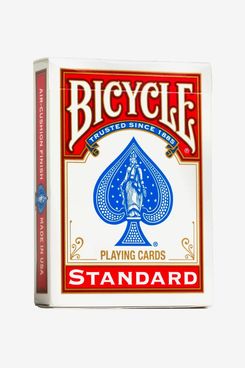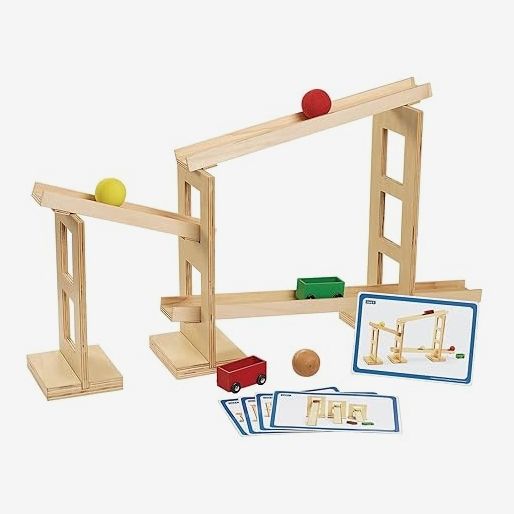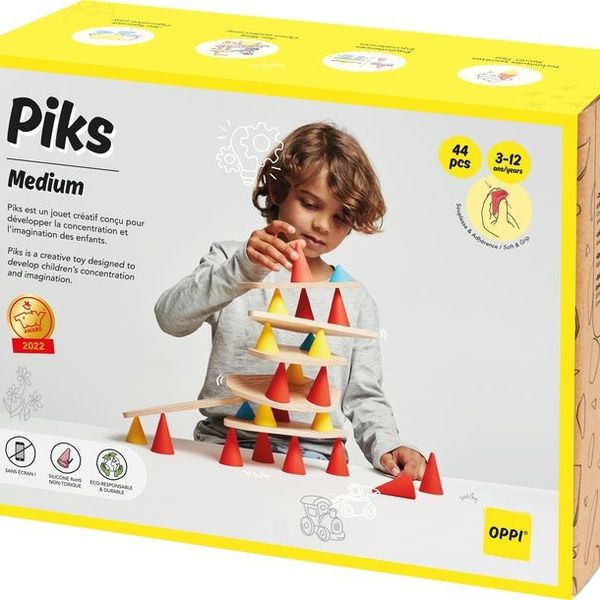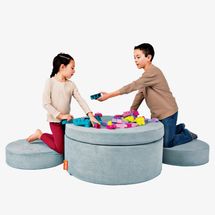
In this article
Kids are famously fickle: One moment they’re obsessed with Paw Patrol, the next they’re on to Taylor Swift. Jeannette Corey, director of the Bank Street Family Center, says that children’s development from birth to age 5 is especially vast, so during this time period, their interests will naturally change very quickly — sometimes even over just weeks or months.
All that rapid development can make it tricky to figure out which toys will keep them engaged for as long as possible — and not just in terms of an afternoon, but over a span of months or even years. And while we can’t predict the future, there are a lot of toys out there that can “grow” with kids through multiple ages and stages. Many will even appeal to siblings and cousins of different ages who are part of the play group too. “Toys that do this best are ones that lend themselves to play that is as hands-on and open-ended as possible and that provide lots of opportunities for creativity, curiosity, problem-solving, and cooperation in different ways as the children’s play skills develop,” Corey explains. To find them, I plucked a few tried-and-true classics from the Strategist archives and asked Corey as well as parents, educators, and other toy experts for their recommendations — all of which you’ll find sorted by price below.
And for even more gift-buying inspiration, check out our guides to the expensive toys that are actually worth it, as well as our big ol’ hub of holiday gift guides for everyone else on your list.
Update on December 13, 2024: Updated prices and checked stock for all products.
$25 and under
Small figurines allow kids to explore the world through their own imaginations, says Corey. They are also easy for kids to return to through the years to explore different themes of play as their language and world knowledge gets more sophisticated.
Schleich’s animal figurines in particular are a go-to for librarian and content creator Hayley DeRoche’s 7- and 10-year-old kids (on top of being a Strategist staff favorite). “They consistently play with them, and that’s better than one can say for a lot of toys,” DeRoche says. She appreciates that the figurines aren’t attached to a specific franchise or character; they’re open-ended, so her kids can make up their own stories with them. Made of sturdy plastic with realistic paint jobs, they come in a wide range of themes, from fantasy creatures to barnyard animals.
There are few things as versatile as a simple deck of cards, because there are so many different games to play with them. Card games are also something the whole family can bond over, says Danyelle Vilmenay, museum-store manager at Louisiana Children’s Museum. She likes the way card games open up the opportunity for kids to connect with their elders and participate in family traditions. Simple games like go fish, old maid, and spoons are great starting points for younger kids and can still be fun for a mixed-age group. (For more game ideas, the Bicycle brand website has a compendium of classic game rules, including recommended ages for play).
Vilmenay also recommends gifting classic board games from your own childhood as another way to uphold family traditions and create opportunities for connection. Whether they’re feeling delight in watching the Rube Goldberg–style Mouse Trap at work or the devastation of getting sent back “home” in a game of Sorry!, kids will form lasting memories from playing group games. “We can give a child any toy, but the memory that goes with it is really what we want you to invest in,” Vilmenay says. Games are also something kids often return to for years, whether on family game night or during sleepovers and hangouts with friends.
Train sets promote interactive play and spark creativity, Vilmenay says. A simple wooden one, like this one from Bigjigs, will hold up over time and has enough pieces for kids to get started — and can be expanded later, another good gift idea down the road. Bigjigs has lots of extra components available, including tunnels, lighthouses, town buildings, and extra tracks. Building train tracks, and the surrounding infrastructure, can also be a great way to kickstart civic-minded thinking, Vilmenay says. It gets kids thinking about what it means to build a community and what a community needs to function.
Once they’re coordinated enough to learn, starting around age 5 or so, a jump rope is something kids can play with for years. DeRoche recommends these jump ropes over ones made with plastic beads or designed for use in the gym, because they’re long-lasting, easy for kids to work with, and hold the “arc” shape well — key for one person to be able to turn the rope while another jumps. “If you actually want your child to play with it and have it be a skill that they can work on, then I would suggest spending a couple more dollars and getting one that’s actual rope,” she says.
Another outdoor toy DeRoche says her elementary-school-aged kids love is this Frisbee-like throwing disc. Traditional Frisbees made from hard plastic can be tricky for young kids — and hey, let’s face it, plenty of adults — to throw well, but DeRoche says this giant, softer version is easy for even little kids to manage. Because the skill barrier to entry is lower (and the injury risk is lower in case of a disc-to-face collision), her whole family enjoys playing with it together.
This wooden set of fruit is a great pretend food toy, especially because most kids will be already familiar with the bananas, apples, and oranges it contains. It comes with a kid-size wooden knife, which can be used to “cut” the Velcro pieces of fruit apart. Vilmenay says kids being able to play pretend with food prep — and model what they see the adults around them do — helps them gain a sense of confidence and independence. They may even gain an appreciation for the work that goes into making food. And because food can be used in all kinds of play and pretend scenarios, it’s something kids can get many years of use out of. Strategist senior editor Jen Trolio has two daughters, ages 6 and 9, who’ve been using this set in all sorts of ways since the older one was about 2.
$50 and under
LEGO’s Duplo blocks are a good starting point for kids under 5, and many will be interested when they’re as young as one. Because the blocks are larger than regular LEGOs, they fit easily in kids’ hands and don’t require as much finesse to build with; they also, crucially, are not a choking hazard. The result is a safer, more satisfying, and less frustrating building experience for younger kids, says Corey.
Special-education teacher and blogger Sally Macaluso keeps this set of Duplo blocks in her preschool classroom, where they are a student-favorite year after year. She also has a set at home, where her 4.5-year-old and 1-year-old child both regularly play them. Macaluso likes that they’re open-ended — they “can be used in multiple ways, don’t come with set instructions, and provide limitless potential,” she says. Trolio adds that even though her daughters now spend more time building complicated Lego sets, she still hasn’t fully put the Duplos away. “Between my own kids and my three nieces, we have five kids in the extended family who range from ages 2 to 9, and they can all find something to do with the Duplos when everyone is together,” she says.
For kids who are are ready to graduate to smaller pieces, the experts I spoke to recommended starting with a classic open-ended set and not rushing into the more elaborate LEGO kits because they offer so much freedom and can appeal to beginners and more seasoned LEGO architects alike. This set comes with 500 pieces and instructions on how to build seven different models with moving parts. Or they can forego the instructions and build whatever they want. The pieces can also be mixed and matched with parts from other LEGO sets for years to come.
If there was a clear winner — in terms of sheer number of recommendations — it would be Magna-Tiles, as just about everyone I spoke to for this story recommended them. They’re extremely popular: Toy consultant and Strategist contributor Youngna Park included the magnetic building tiles in her roundup of the best open-ended toys, and toy writer Liza Corsillo predicts they’ll go down in history as one of the best toys of this era. Trolio has even declared them the single most important toy her household has ever known.
Like LEGOs, Magna-Tiles can be endlessly remixed and reused. Also like LEGOs, there are packs of standard shapes, as well as themed kits where kids can build a castles, a space shuttle, or a construction site. Where they differ from LEGOs is that the flat, geometric shapes are easier connect to each other and pull apart, so even very young kids can start building. “My 3- and 6-year-olds are fighting each other every night over who can build a better tower — and who is allowed to knock it over,” says Clarissa Hong, Vox vice-president of revenue accounting. After starting out with very simple structures around age 2, Trolio’s 6- and 9-year-olds still regularly cover the family’s living-room floor with elaborate, multi-room buildings and worlds that they sometimes use in combination with other toys like Barbies or action figures.
But when it is time to put them away, many of the parents I spoke to also appreciate how the magnets make clean-up very streamlined, since the pieces all stick and stack together. “And they don’t hurt when you step on them,” DeRoche adds.
For blocks with an heirloom quality, Vilmenay suggests the Uncle Goose brand. They’re handmade and painted in Michigan in a variety of delightful and educational designs. The wood is untreated, the paints are nontoxic, and the blocks are too large to be a choking hazard, making them safe for play for toddlers. They’re also extremely durable — Vilmenay says she has “seen them in the museum being played with in our galleries day in and day out, sanitized day in and day out,” and they hold up well.
Because Uncle Goose makes such a wide range of designs — including science blocks featuring the phases of the moon, planets, elements from the periodic table, and dinosaurs, and themed block play sets featuring sea life, barn animals, and forest animals — they also work well for older kids. Vilmenay particularly recommends the language blocks as a toy that will help kids develop their dexterity and fine motor skills while expanding their vocabulary. She also loves the brand’s inclusivity — Uncle Goose sells braille and American Sign Language blocks, and the rest of the language collection covers 24 spoken languages, including Arabic, Cherokee, Hindi, and Hebrew.
Park also recommends these “classic preschool building blocks” because they are simple, versatile, and basically indestructible. There’s enough variety in the shapes to make these interesting to build with, while still very much being a blank slate for kids’ imagination. Their relative affordability in terms of price per block means they’re also a good way to add a lot of pieces to your home’s block bin, and they can easily be combined with more design-y blocks like the Uncle Goose ones above.
Rachel Coler-Mulholland, professor of psychology at the University of Minnesota Morris and a licensed professional counselor, says Lincoln Logs are one of the best building toys that grow with kids. The log-shaped pieces have notches, allowing kids to stack them up to build log cabins — or whatever else their heart desires — and the building mechanism is easy enough for kids as young as 3. Mulholland recommends buying a higher quantity of pieces since you can build more that way. This set comes with over 100 pieces, which can be conveniently stored in the canister they come in. Like LEGOs and other building toys on this list, Lincoln Logs are something many adults will also enjoy playing with — Mulholland says even her university students told her that Lincoln Logs are “still fire.”
These types of wooden nesting blocks are frequently found in Montessori and Waldorf classrooms, Corsillo says in her gift guide for 1-year-olds, because they can be stacked and combined in a bunch of different ways. The shapes allow kids to experiment with gravity and balance, and can be continually repurposed in creative ways: What starts out as a simple building toy for younger kids can become a ramp for Hot Wheels, a bridge in a doll’s town, or a Skee-ball target as they get older.
It may not look like much, but this hard plastic shell “can be climbed on, sat in, spun, worn as a hat, used as a shield — all sorts of adventures for little imaginations,” says Coler-Mulholland. It’s designed for kids ages 2 and older, but Mulholland says she’s seen kids as old as 10 enjoy playing with it.
Kidspace Children’s Museum senior retail manager Kathleen Hickey recommended this engineering set that’s focused on chain reactions: With dominos, wheels, mallets, and seesaws, kids can set up all kinds of circuits for a marble to move through. The set can also be combined with others from the same brand to build larger and larger contraptions of cause and effect. It’s recommended for kids 7 and up, but could easily be enjoyed all the way through the tween years. Siblings of multiple ages especially might enjoy playing with this set together.
DeRoche bought this Kodak film camera when her daughter was 8 years old; she’s now 10, and they’ve gotten great use out of it. It’s a traditional film camera but takes two images per frame, which helps lower the cost of film per photo. DeRoche likes that it’s easy to use, durable, and allows her daughter to take great photos while also teaching some patience during the wait time to get the film developed. “I don’t think introducing something with a little delayed gratification is a negative,” DeRoche says. “So much of what kids consume is instantaneous for them.”
$100 and under
Coler-Mulholland says this engineering set with ramps is similar to a marble run but a bit more accessible for preschool-age kids. It’s larger than the Zig & Go set above with less focus on small pieces. But because of the multiple ways kids can build and experiment with it, it’s something they can enjoy well past the younger years. She says it’s also highly collaborative, so it’s a great toy for siblings and friends to play with together.
“We fell in love with Piks watching a video of kids laughing their heads off and have given it to all the kids in our lives since,” says Kasey Coyle, director of operations at Kidding Around toy store in New York. This topsy-turvy building set includes 33 silicone cones and 11 wooden boards to balance on them, which presents a slightly different building challenge than classic blocks or Magna-Tiles. The set includes “challenge cards,” which have builds that kids can try to re-create, or they can invent their own balancing builds. Coyle says it’s great toy for kids to play with together as they can either cooperatively build or challenge each other. That “challenge” aspect gives it additional longevity as kids get older — while toddlers may enjoy simply experimenting with building, elementary-age kids and up can create games to compete with their friends or siblings.
Pediatric occupational therapist, author, and blogger Keri Wilmot recommended GraviTrax as another building toy that, like LEGOs, kids can play with either by following instructions or using their imaginations to create whatever they want. With GraviTrax, those creations are interactive marble runs with features like catapults, elevators, bridges, and zip lines. This set is designed for ages 8 and up, but should have some staying power even as they get older since the design isn’t babyish. For kids ages 3 to 7, there is also a line of GraviTrax’s Junior sets that are a bit simpler to use.
The flat, flexible Clixo pieces snap together with magnets and can be used to build all kinds of 2-D or 3-D creations. Lay the pieces flat against each other to create a two-dimensional scene, or bend, twist, and shape them into three-dimensional objects. Hickey recommends Clixo because they’re unique compared to other building toys (Park also recommends them in her building-toy guide). That makes for a different building experience that kids can enjoy from the toddler years all the way through upper elementary school. The simple, open-ended rainbow starter packs are great for toddlers, but Corsillo recommends larger kits and the more advanced themed kits for kids around 8, who are ready to take on the origami-like challenges of building more complex designs.
Not only does an easel give kids a dedicated place to create, but standing up to work on their art pieces can also help kids develop core strength and large motor skills. This one from Melissa & Doug is our top pick for kids’ art easels and would make a great long-lasting gift because you can adjust the height, it folds up easily for storage, and it has a dry-erase board on one side and a chalkboard on the other with a dowel between to hold a roll of drawing paper.
Play-fighting my neighborhood friends with plastic Star Wars lightsabers was a big part of my childhood, and I had never even seen the movies. That’s because even for the non-fans, there is something irresistible about dueling with the franchise’s signature weapon. While there are plenty of toy lightsabers out there, they are generally made of plastic, and often don’t hold up to heavy-duty play. DeRoche says her 7- and 10-year-old kids both love these wooden swords that are much more durable while still being lightweight enough to play with. Though because of the strength required to lift them — not to mention the maturity to play at least somewhat safely — DeRoche says these are best suited to kids over 6.
Hickey recommends this artfully designed cornhole game as a fun and interactive way for kids to play together with each other or with grownups, while learning cooperation and turn-taking. While cornhole is traditionally played outside, this set is small enough to be used indoors too (and stored easily). Its small size is well-suited to toddlers, but the simplicity of the game makes it one the whole family can play.
DeRoche says these play silks are “workhorses in disguise.” These colorful swaths of fabric can be used for everything from playing dress-up to building forts to playing peekaboo, depending on who’s using them — maybe one day they’re a little kid’s superhero cape, and another they’re the backdrop for a bigger kid’s theatrical performance. Sarah’s Silks are the go-to brand, recommended by DeRoche, Vilmenay, Corsillo, and dozens of other parents and educators we’ve spoken to over the years. Their durability helps make them worth the splurge; DeRoche says she has seen her kids use them “every which way” and they’ve never torn.
Yoto’s screen-free audio players were frequently mentioned to me by parents as “investments” that have lasted their children for years. The players can connect to Wi-Fi and stream audio through the Yoto app, or they can be used without Wi-Fi by inserting a music or story card into a slot on the side of the player, so that kids can listen to audiobooks and music. Occupational therapist Kelsie Olds says the Yoto a great way to keep young kids from having free access to the internet, while allowing them to listen to music on their own, in a way they have control over. Kathryn VanArendonk, a Vulture critic who wrote an ode to the Yoto Player back in 2022, says the Yoto Player has a longer life span than the also-popular Toniebox, which uses plastic figurines to select audio instead of cards. VanArendonk prefers the Yoto Player because it’s easier to travel with, has better functionality for skipping songs, and because the cards contain longer audio tracks than the Toniebox’s 90-minute limit — beneficial for older kids with longer attention spans.
Play kitchens were also frequently mentioned. Like the cuttable play food above, play kitchens let kids make sense of the real world through dramatic play. This one from Hape is our favorite play kitchen because of its durable wooden build and simple design. Wee Talkers founders Carly Tulloch and Katie Sterbenz both also recommended it to me, saying it’s one of the most played with items in both of their homes by kids ages 9 months to 4 years old.
Over $100
Or for a different angle of pretend play with food, consider this wooden supermarket set that pediatric physical therapist KC Rickered recommends and that is especially good for kids to play with together in groups.
This air-powered building toy, which is also one of our favorite STEM toys, lets kids create their own arrangements of transparent tubing for foam balls to fly through. They can also adjust the airflow to see how different levels of air pressure affect how the balls move, and experiment with making them hover or shoot out of an open tube. Corey says this can be a great family activity, or something kids can do alone, but either way it’s easy to play with for hours. Because it’s recommended for kids 3 and up, it’s another great option for siblings of multiple ages to play with together.
Multiple parents sang the praises of the Nugget play couch and its newer sibling, the Chunk ottoman, as toys that their kids of multiple ages have used for years. The modular, fabric-covered foam pieces can be used for lounging and relaxing, sure, but they’re much more frequently deployed to build forts, obstacle courses, tunnels, and whatever else kids can imagine. They also make great cushions for wrestling, gymnastics, and generally jumping around without destroying the cushions of your actual couch.
Yes, it’s another marble-run toy, but DeRoche says this handcrafted one is the best toy she has ever purchased; her 7- and 10-year-old kids are still playing with it six years after she originally bought it. “You don’t have to engineer the marble-run aspect,” DeRoche says. “It just is there. And I know sometimes in STEM-focused child-rearing that’s seen as a negative, but I also think sometimes you just want to see the marbles go.”
Wilmot recommends a sturdy, unbranded dollhouse like this one from KidKraft so that it can be used for whichever dolls the child likes to play with at a given time. For example, it’s not a Barbie Dreamhouse, but it can fit Barbies, along with other 12-inch dolls.
The Strategist is designed to surface useful, expert recommendations for things to buy across the vast e-commerce landscape. Every product is independently selected by our team of editors, whom you can read about here. We update links when possible, but note that deals can expire and all prices are subject to change.

































































